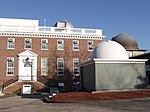Asa Gray House
Houses completed in 1810Houses on the National Register of Historic Places in Cambridge, MassachusettsNational Historic Landmarks in Massachusetts

The Asa Gray House, recorded in an HABS survey as the Garden House, is a historic house at 88 Garden Street, Cambridge, Massachusetts. A National Historic Landmark, it is notable architecturally as the earliest known work of the designer and architect Ithiel Town, and historically as the residence of several Harvard College luminaries. Its most notable occupant was Asa Gray (1810–88), a leading botanist who published the first complete work on American flora, and was a vigorous defender of the Darwinian theory of evolution.
Excerpt from the Wikipedia article Asa Gray House (License: CC BY-SA 3.0, Authors, Images).Asa Gray House
Garden Street, Cambridge
Geographical coordinates (GPS) Address External links Nearby Places Show on map
Geographical coordinates (GPS)
| Latitude | Longitude |
|---|---|
| N 42.382972222222 ° | E -71.128 ° |
Address
Asa Gray House
Garden Street 88
02138 Cambridge
Massachusetts, United States
Open on Google Maps










